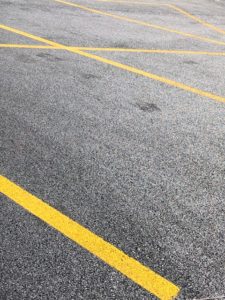 One morning the other week, I decided to make a quick trip to my neighborhood grocery store.
One morning the other week, I decided to make a quick trip to my neighborhood grocery store.
It was still early, before 9:00 at least. I had walked and fed the dog already, but I had not yet plunged into my “to-do” list.
As I pulled into the lot, I kept telling myself not to forget the reusable handled totes in the backseat, which I often do.
A small truck from Edgewater Produce occupied a spot near the entrance. I marveled at how, despite advances in technology, some things still had to be done the old-fashioned way. Two men and a forklift unloaded crates of plums from Mexico and zucchini raised in a nearby state.
As soon as I got out of my car, I felt irritation in my nostrils, accompanied by an acrid smell.
What was that smell?
I looked around the lot. I have probably parked in every one of their spaces over the years, thankful that the yellow diagonal lines were not set together as tightly as they place them in Trader Joe’s lots.
Then it dawned on me. Last night, they must have poured new asphalt and painted in new yellow lines. They perfectly matched the layout and configuration that occupied the space the day before.
There were no more, nor fewer spaces. Arrows guided you to enter the lot on a side street and exit on Lawrence. Two spots designated for handicapped drivers remained closest to the store entrance. The dumpster was in the same space.
But everything felt just a little different.
It was as if the odor, probably from the sealant, challenged me to pay attention, pay attention to the subtle differences.
I smiled, thinking about the improved levelness of the lot. While the lot at HarvesTime was never especially bad, I could point out some grocery store parking lots that are so uneven that unattended carts can easily roll away until they crash into a nearby car.
I examined the new lines, diagonal in some areas, straight in others. The new lines were probably painted in the same shade of yellow as the last coat, but because of the darker surface of the newly poured asphalt, using the lines as references was easier.
The odor would wear off quickly, I decided, but how long would I be conscious that where I stood was new. I wondered how could I be excited over something being new when it is an exact replica of a previous version of itself.
Change or distinctions between things can be subtle. A new haircut or new sweater or new route to a familiar destination can go unnoticed. New doesn’t always mean “improved.”
I thought about what it means for something to be new.
I felt happy returning my car after shopping. Maybe I became immune to the smell.
I thought about the idea that skin regenerates itself every four weeks or so. Even though a local contractor poured the asphalt and the surface of the lot didn’t regenerate itself, I liked the idea that the lot was able to greet customers with new skin.
New is not defined by the age of something, but by the experience. Something is new when it is worn or tasted or touched, heard or seen as if “for the first time.”
One can buy a used car still have a new vehicle. A new home has generally been lived in before. Trying a new restaurant or snagging an attractive piece of jewelry from a thrift store doesn’t mean it doesn’t have a previous history.
Regenerating skin or shifting perspective; each day is an opportunity to experience something in a new way.
Understanding that experiencing something new is about YOU, in your capacity to appreciate subtle differences in the world and in yourself, is no small thing.


Leave a comment